Sugarcane (Saccharum spp. interspecific hybrids) is an important crop cultivated on organic soils in the Everglades Agricultural Area (EAA) and surrounding mineral soils in southern Florida. Florida is a leading producer of sugarcane in the United States with an average of 400,000 acres of production over the last two decades (VanWeelden et al. 2020). The sugarcane crop in Florida is cultivated in rotation with several crops, including rice (Oryza sativa L.), during the sugarcane fallow renovation period. Rice cultivated on approximately 25,000 acres, mainly on organic soils in the EAA, provides income to growers and also provides important ecosystem services, including soil health improvement and reduction of soil subsidence or soil loss due to oxidation (Bhadha et al. 2020). Flooded rice fields also negatively influence populations of corn wireworm (Melanotus communis), an important insect pest of sugarcane in the region (Cherry 2017). In Florida, sugarcane is vegetatively propagated by planting stalk sections while rice is drill-seeded. Several weed species such as broadleaves, grasses, and sedges infest Florida sugarcane and rice fields. Sedges are among the most common and troublesome weeds associated with sugarcane and rice production in Florida (Rott et al. 2018; Webster 2012). After planting, sedges can emerge prior to crop emergence or at any time during the sugarcane growing season.
Sedges are grass-like plants with parallel leaf venation and aerial flower-bearing stems in the family Cyperaceae composed of approximately 3,000 species, with roughly 220 species considered as weeds (Bendixen and Nandihalli 1987). A majority of these sedge species in crops such as sugarcane and rice are in the genus Cyperus (Etheredge et al. 2010). The most common and problematic sedges found in Florida sugarcane and rice are purple nutsedge and yellow nutsedge, with the latter being the most prevalent. These two species may be found growing together in fields and are difficult to distinguish if flowers are absent. They are common in sugarcane and rice in Florida due to their ability to tolerate a wide range of soil types, wet soils, and poorly drained soils, and their ability to grow under flooded rice conditions. Less problematic sedges found in these cropping systems include annual sedge, flatsedge, and rice flatsedge. This article describes the biology and control options for sedges associated with sugarcane and rice in Florida to assist growers in making correct identification and appropriate management decisions to help control these species.
Purple Nutsedge
Purple nutsedge (Cyperus rotundus L.) is a herbaceous perennial weed native to Eurasia (Bryson and DeFelice 2009). In the continental United States, it is found in Texas to Virginia, Maryland, Delaware, Pennsylvania, and New Jersey, and in Arizona, California, and Oregon (Murphy et al. 2013; USDA 2020b). Purple nutsedge is found throughout Florida from the Panhandle to the Keys (USDA 2020b). The distribution of purple nutsedge is limited by low temperature and moisture (Bendixen and Nandihalli 1987), which are not limiting environmental factors in southern Florida where sugarcane and rice are cultivated.
Biology and Life Cycle
Purple nutsedge is a rapidly spreading sedge with tubers and underground runners or rhizomes. Seedlings of purple nutsedge are inconspicuous and rare to find because the plant spreads almost exclusively via rhizomes and tubers (Stoller and Sweet 1987). The leaves are shiny, dark green, linear, flat or slightly corrugated, approximately 1/16 inch to ¼ inch wide and 6 to 12 inches long with a prominent midvein, and formed in groups of three (i.e., three-ranked). The leaves abruptly taper to a sharp point at the tip and are often described as “boat-shaped” (Figure 1). The stem is triangular, smooth, solitary, and 4 inches to 6 inches tall. Purple nutsedge has reddish-purple to reddish-brown flowers formed at the end of stems and 2 to 4 leaflike bracts below the flowers (Figure 2). Although flowers sometimes develop into mature viable seeds, propagation is primarily by rough, irregularly shaped tubers connected by wiry rhizomes which are underground stems (Figure 3). Purple nutsedge flowering occurs at 12-hour photoperiod indicating that it has an intermediate flowering response to daylength (Williams 1978). However, daylength does not affect tuber formation dramatically compared to high temperatures, which stimulate tuber formation (Stroller and Sweet 1987). The survival of these tubers increases with soil depth (Stroller and Sweet 1987).
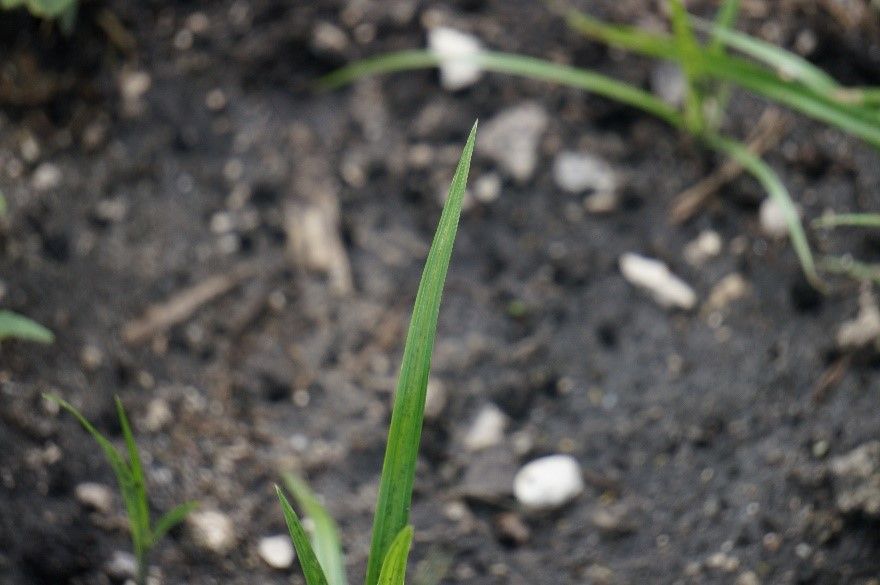
Credit: D. C. Odero, UF/IFAS
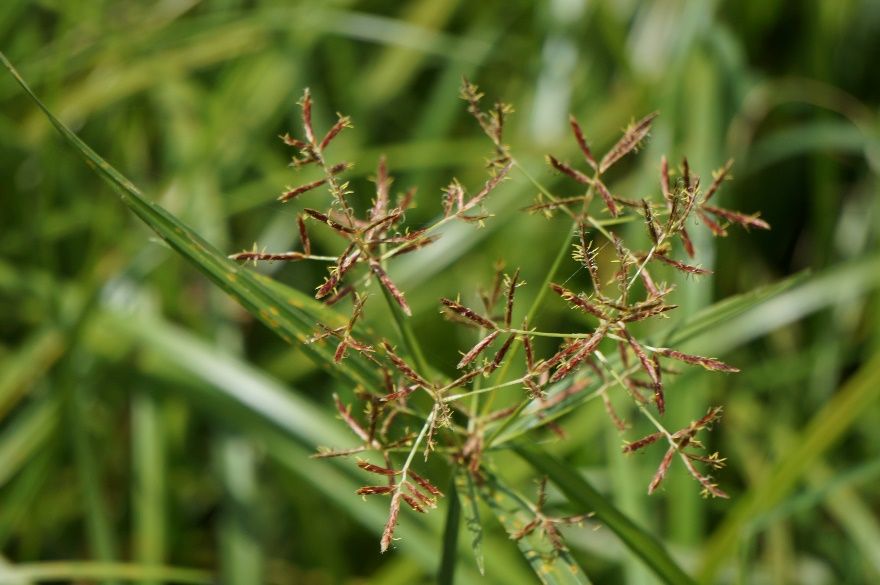
Credit: D. C. Odero, UF/IFAS

Credit: D. C. Odero, UF/IFAS
Yellow Nutsedge
Yellow nutsedge (Cyperus esculentus L.) is a herbaceous perennial weed native to North America found throughout the United States with the exception of Montana and Wyoming (Bryson and DeFelice 2009; Murphy et al. 2013; USDA 2020a). In Florida, yellow nutsedge is found from the Panhandle to the Keys (USDA 2020b). Yellow nutsedge is found within a wider geographic area compared to purple nutsedge because it is more tolerant of cold and drought (Bendixen and Nandihalli 1987).
Biology and Life Cycle
Yellow nutsedge is a rapidly spreading sedge that forms tubers at the end of the rhizomes. Similar to purple nutsedge, the seedling is small, inconspicuous, and rarely found because it also spreads almost exclusively by rhizomes and tubers. The basal leaves formed in groups of three are flat or slightly corrugated, and usually longer than the flowering stem. Leaf blades are bright green, narrow or linear, and 1/16 inch to 7/16 inch wide. The leaf tips are long and attenuated, gradually tapering to a thin, sharp point (Figure 4). The stem is triangular in cross section and 6 inches to 2 1/2 feet tall. The flower is yellowish-brown or straw colored and formed at the end of the stem with 3 to 7 conspicuous leaves below (Figure 5). The seed is brown and less than 1/16 inch long. Tubers are round, smooth, and formed at the ends of whitish rhizomes (Figure 6). Unlike purple nutsedge, yellow nutsedge does not form groups of tubers connected by wiry chains (Figure 3). Propagation is primarily by tubers, and rarely by seeds (Stroller and Sweet 1987; Bendixen and Nandihalli 1987). Tuber survival increases with soil depth; they can emerge from deep in the soil (Figure 7) and remain viable for more than 10 years (Stroller and Sweet 1987).
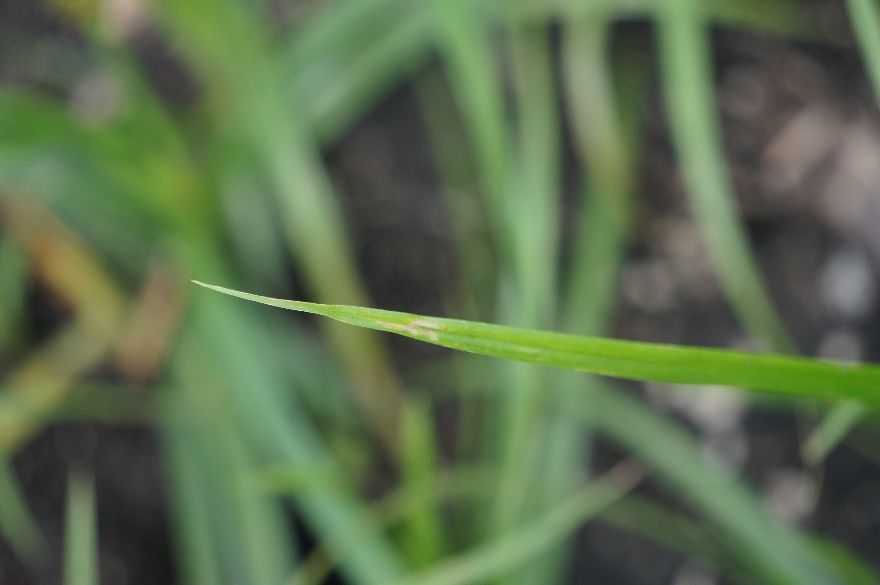
Credit: D. C. Odero, UF/IFAS

Credit: D. C. Odero, UF/IFAS

Credit: D. C. Odero, UF/IFAS
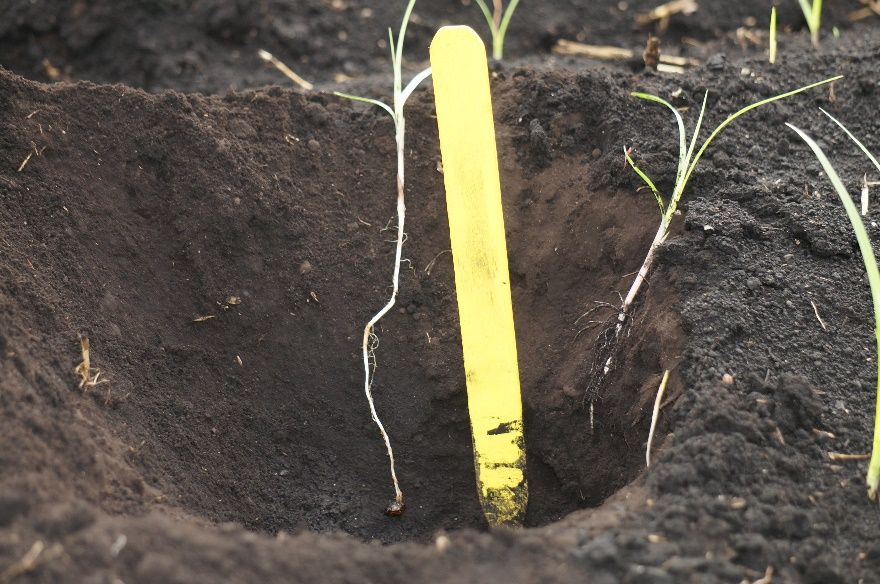
Credit: D. C. Odero, UF/IFAS
Other Sedges
Unlike the perennial growth habits that describe purple and yellow nutsedge, the annual sedge (Cyperus compressus L.), flatsedge (Cyperus odoratus L.), and rice flatsedge (Cyperus iria L.) are annual sedges. These sedge species are also commonly found in the EAA, mainly in rice fields. They do not produce tubers and propagation is by seed. Their leaves are linear and formed in groups of three, and roots are fibrous and branched. Roots of annual sedge are red, rice flatsedge roots are yellowish-red, and flatsedge roots are brown. Roots of annual sedge are also aromatic. A key characteristic to differentiate these three species is the flower or seed head. Flowers of annual sedge are clusters or flat and are greenish-white in color with toothed margins (Figure 8). Flatsedge has tan or brown flowers with 3 to 10 small and conspicuous leaves or bracts (Figure 9). Flowers of rice flatsedge are composed of elongated spikes with 3 to 7 leaflike bracts. The lowest bract is longer than the inflorescence, and spikelets of individual spikes are crowded and golden brown (Figure 10).
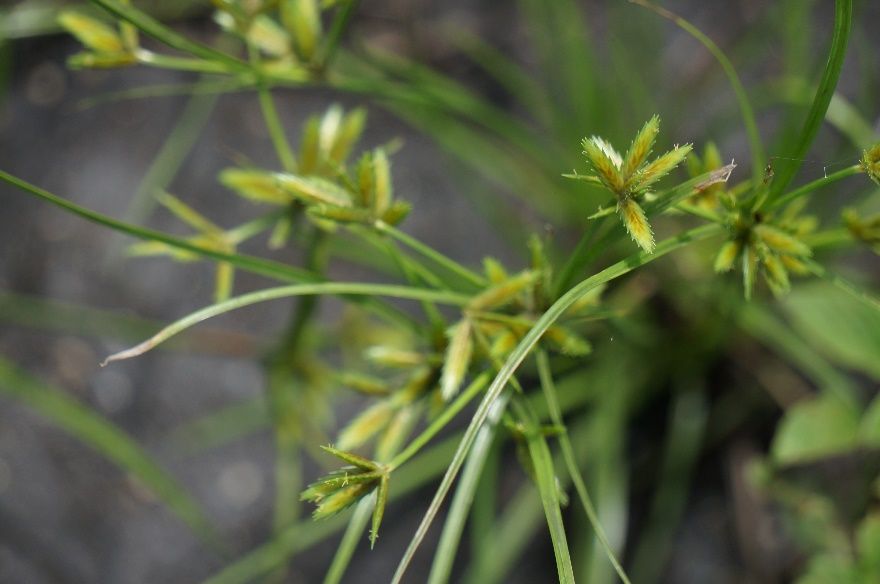
Credit: D. C. Odero, UF/IFAS
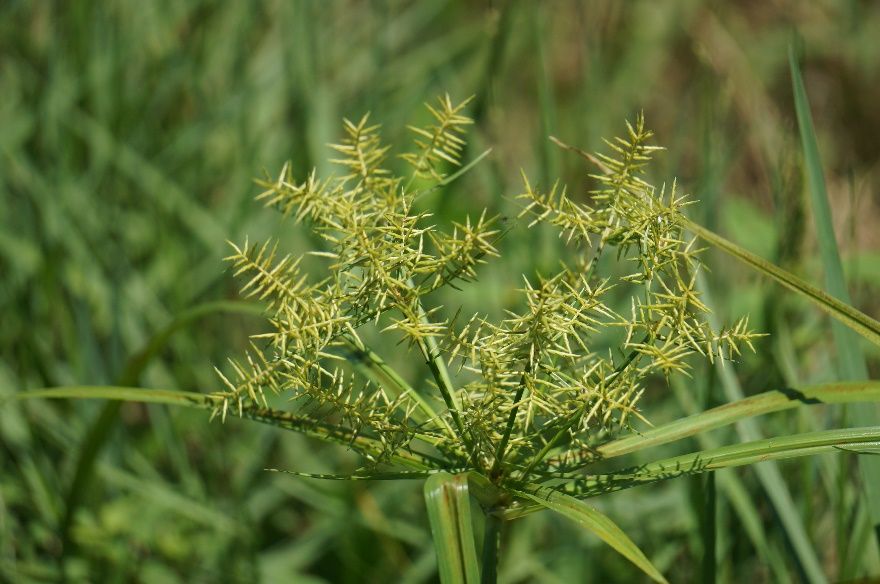
Credit: D. C. Odero, UF/IFAS
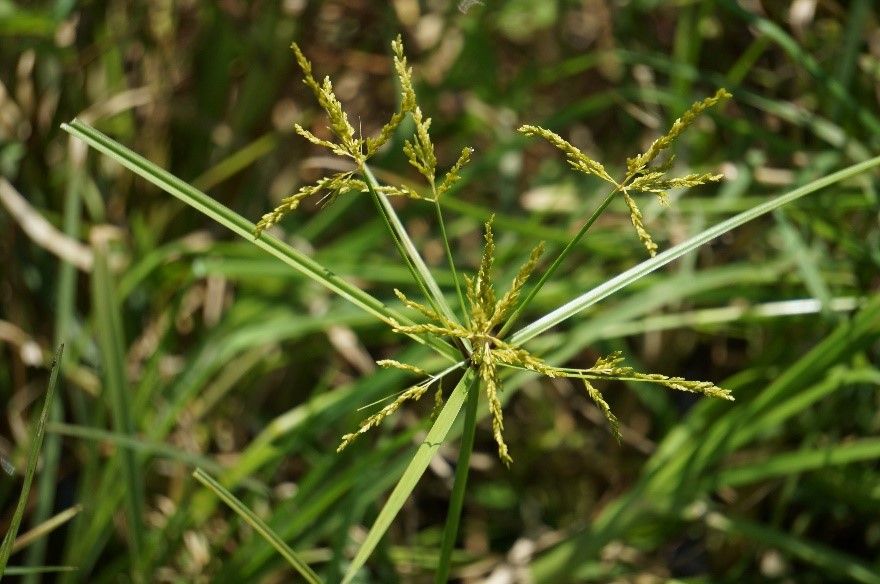
Credit: D. C. Odero, UF/IFAS
Control of Sedges in Sugarcane and Rice
There are a few herbicides available for control of sedges in sugarcane and rice (Table 1). These herbicides must be used in conjunction with other weed management tools such as crop rotation and cultivation to obtain maximum benefit. In addition, healthy competitive crop stands with the ability to close canopy and shade nutsedges enhance their control. The herbicides can be applied preemergence or postemergence. However, there are no preemergence herbicides for sedge control in Florida rice. Proper timing of herbicide application with respect to the growth stage of the weeds is very important. Efficacy of these herbicides on sedges will be achieved when the weeds are under 4 inches to 8 inches in height. Always read the label for the proper time of application of each herbicide.
Table 1. Sedge control in sugarcane and rice. Contact: Extension weed specialist (dcodero@ufl.edu). This table lists registered pesticides that should be integrated with other pest management methods. Contact your local UF/IFAS Extension office for additional information (https://sfyl.ifas.ufl.edu/find-your-local-office).
References
Bendixen, L. B., and U. B. Nandihalli. 1987. “Worldwide Distribution of Purple and Yellow Nutsedge (Cyperus rotundus and C. esculentus).” Weed Technology 1:61–65.
Bhadha, J. H., A. L. Wright, and G. H. Snyder. 2020. Everglades Agricultural Area Soil Subsidence and Sustainability. SL 311. Gainesville: University of Florida Institute of Food and Agricultural Sciences. https://edis.ifas.ufl.edu/ss523
Bryson, C. T., and M. S. DeFelice (Eds.). 2009. Weeds of the South. Athens, GA: University of Georgia Press.
Cherry, R. H. 2017. Wireworms in Florida Sugarcane. ENY-665. Gainesville: University of Florida Institute of Food and Agricultural Sciences. https://edis.ifas.ufl.edu/sc013
Etheredge, Jr., L. M., J. L. Griffin, and J. M. Boudreaux. 2010. “Purple Nutsedge (Cyperus rotundus) Competition with Sugarcane and Response to Shade.” Journal of American Society of Sugar Cane Technologists 30:89–103.
Murphy, T. R., D. L. Colvin, R. Dickens, J. W. Everest, D. Hall, and L. B. McCarty. 2013. Weeds of Southern Turfgrasses. Special bulletin 31. Athens, GA: University of Georgia Extension Publications.
Rott, P., D. C. Odero, J. M. Beuzelin, R. N. Raid, M. VanWeelden, S. Swanson, and M. Mossler. 2018. Florida Crop/Pest Profile: Sugarcane. PI-171. Gainesville: University of Florida Institute of Food and Agricultural Sciences. https://edis.ifas.ufl.edu/pi207
Stoller, E. W., and R. D. Sweet. 1987. “Biology and Life Cycle of Purple and Yellow Nutsedges (Cyperus rotundus and C. esculentus).” Weed Technology 1:66–73.
USDA (United States Department of Agriculture) Natural Resources Conservation Service. 2020a. “Cyperus esculentus L. Yellow Nutsedge.” Accessed December 28, 2020. https://plants.usda.gov/core/profile?symbol=cyes
USDA (United States Department of Agriculture) Natural Resources Conservation Service. 2020b. “Cyperus rotundus L. Nutgrass.” Accessed December 28, 2020. https://plants.usda.gov/core/profile?symbol=CYRO
VanWeelden, M. T., S. Swanson, W. Davidson, M. Baltazar, and R. Rice. 2020. “Sugarcane Variety Census: Florida 2019.” Sugar Journal 83(2): 8–23.
Webster, T. M. 2012. “Weed Survey - Southern States. Grass Subsection.” Proceedings of the Southern Weed Science Society 65:267–288.
Williams, R. D. 1978. “Photoperiod Effects on the Reproductive Biology of Purple Nutsedge (Cyperus rotundus).” Weed Science 26:539–542.